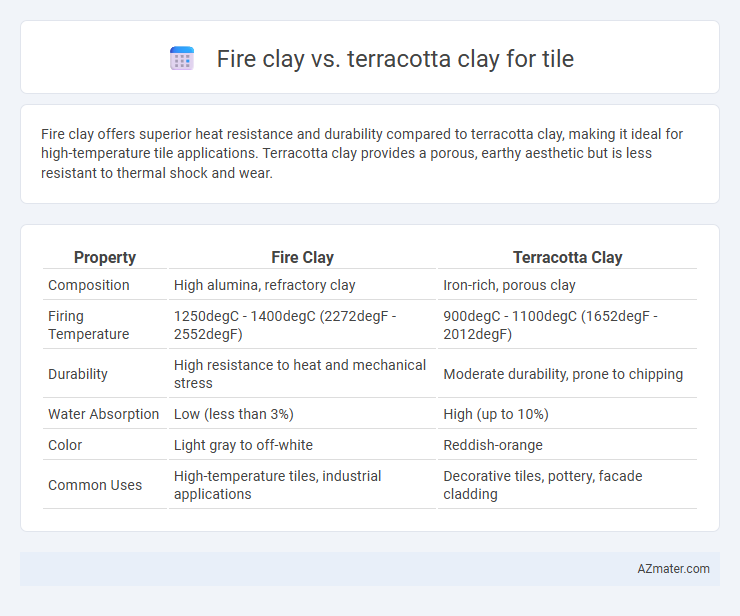Fire clay offers superior heat resistance and durability compared to terracotta clay, making it ideal for high-temperature tile applications. Terracotta clay provides a porous, earthy aesthetic but is less resistant to thermal shock and wear.
Table of Comparison
| Property | Fire Clay | Terracotta Clay |
|---|---|---|
| Composition | High alumina, refractory clay | Iron-rich, porous clay |
| Firing Temperature | 1250degC - 1400degC (2272degF - 2552degF) | 900degC - 1100degC (1652degF - 2012degF) |
| Durability | High resistance to heat and mechanical stress | Moderate durability, prone to chipping |
| Water Absorption | Low (less than 3%) | High (up to 10%) |
| Color | Light gray to off-white | Reddish-orange |
| Common Uses | High-temperature tiles, industrial applications | Decorative tiles, pottery, facade cladding |
Introduction to Fire Clay and Terracotta Clay
Fire clay is a highly refractory material known for its ability to withstand extreme heat, making it ideal for kiln linings and high-temperature tile applications. Terracotta clay, composed primarily of iron-rich natural clay, is prized for its porous, heat-retentive properties and characteristic reddish-brown color, commonly used in decorative and rustic tiles. Both clays serve distinct purposes in tile production, with fire clay offering superior thermal resistance and terracotta clay providing aesthetic warmth and durability.
Composition and Mineral Content
Fire clay contains high amounts of alumina and silica, providing excellent heat resistance and durability ideal for tile applications exposed to high temperatures. Terracotta clay is rich in iron oxide, giving it its distinctive reddish-brown color but lower firing temperature and strength compared to fire clay. The mineral content in fire clay ensures better vitrification and mechanical strength in tiles, while terracotta offers a more porous and softer texture suitable for decorative purposes.
Firing Temperatures and Durability
Fire clay tiles are known for their high firing temperatures, typically ranging from 1,200degC to 1,400degC, which results in increased vitrification and enhanced durability. Terracotta clay tiles are fired at lower temperatures, generally between 1,000degC and 1,100degC, producing a more porous and less dense material. The higher firing temperature of fire clay makes it more resistant to chipping and wear, making it ideal for heavy-duty applications, while terracotta is better suited for decorative or light-use areas due to its softer, more fragile nature.
Color and Aesthetic Differences
Fire clay tiles exhibit a natural, earthy tone ranging from beige to off-white, creating a clean and sophisticated aesthetic ideal for contemporary designs. Terracotta clay offers warm, rich hues of reddish-orange and brown, delivering a rustic and traditional look that enhances Mediterranean or farmhouse styles. The distinct color palettes of fire clay and terracotta significantly influence tile aesthetics, making fire clay suited for sleek, modern spaces and terracotta perfect for inviting, warm environments.
Water Absorption and Porosity
Fire clay exhibits lower water absorption rates, typically below 3%, making it highly resistant to moisture and suitable for high-durability tile applications. Terracotta clay, with water absorption rates ranging from 10% to 20%, has higher porosity, resulting in increased vulnerability to water damage and requiring sealing for tile use. The denser microstructure of fire clay contributes to its reduced porosity compared to the more porous terracotta, which affects tile longevity and maintenance.
Suitability for Indoor and Outdoor Tiles
Fire clay offers superior durability and resistance to high temperatures, making it ideal for outdoor tiles exposed to harsh weather conditions and thermal fluctuations. Terracotta clay, while aesthetically warm and porous, is better suited for indoor tiles where moisture exposure is limited and environmental stress is minimal. The dense, vitrified nature of fire clay enhances its suitability for exterior applications, whereas terracotta's natural absorption properties favor controlled indoor environments.
Cost and Availability Comparison
Fire clay tiles typically cost more due to their higher durability and heat resistance, making them suitable for high-temperature applications. Terracotta clay is generally more affordable and widely available, favored for decorative and low-stress environments. Availability of fire clay can be limited and region-specific, whereas terracotta clay is commonly sourced and easier to find globally.
Installation and Maintenance
Fire clay tiles offer enhanced durability and resistance to thermal shock, making them ideal for high-heat applications; they require minimal sealing and can be cleaned with mild detergents, simplifying maintenance. Terracotta tiles, while naturally porous and warm-toned, demand thorough sealing before installation to prevent moisture absorption and staining, with regular resealing necessary to maintain longevity. The installation of fire clay tiles is slightly more forgiving due to their uniform density, whereas terracotta necessitates careful handling and specialized grouts to accommodate potential expansion and prevent cracks.
Common Applications in Tiling
Fire clay is widely used for durable, heat-resistant tiles in high-temperature environments such as fireplaces, stoves, and industrial flooring due to its strength and thermal stability. Terracotta clay, known for its porous nature and warm, reddish tones, is commonly applied in decorative wall tiles, rustic flooring, and outdoor patios where aesthetic appeal and breathability are prioritized. Both clays serve distinct functional roles, with fire clay excelling in heavy-duty, heat-exposed tiling and terracotta favored for traditional, artisanal finishes.
Choosing the Right Clay for Your Tile Project
Fire clay offers superior durability and high firing temperatures, making it ideal for tiles exposed to intense heat or heavy wear, while terracotta clay provides a warm, rustic aesthetic suitable for decorative, low-traffic areas. The choice depends on the project's functional demands and desired finish--fire clay delivers strength and longevity for high-performance tiles, whereas terracotta emphasizes natural, earthy tones and texture. Selecting fire clay ensures resistance to cracking and moisture, whereas terracotta requires proper sealing to prevent damage over time.

Infographic: Fire clay vs Terracotta clay for Tile
 azmater.com
azmater.com